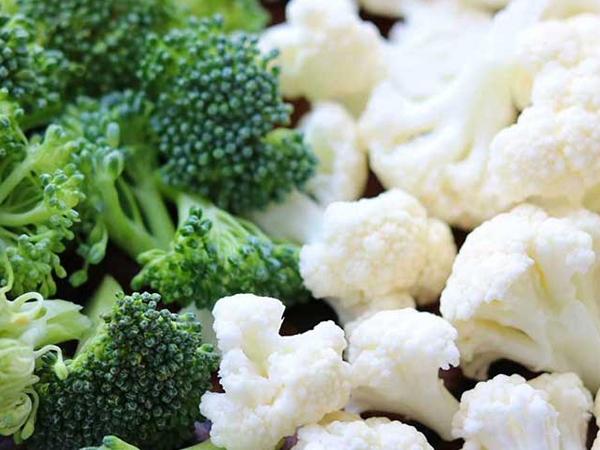(Cabbage (red, white, Savoy
Description
The cabbage plant, Brassica oleracea, is an herbaceous annual or biennial vegetable in the family Brassicaceae grown for its edible head. There are many different varieties of cabbage which include the white and red cabbage (Brassica oleracea var. capitata) and the savoy cabbage (Brassica oleracea var. sabauda. The head of the cabbage is round and forms on a short thick stem. The leaves are thick and alternating with wavy or lobed edges and the roots are are fibrous and shallow. The plant produces large yellow flowers. The densely leaved heads can range in size from 0.5 to 3.6 kg (1-8 lb) depending on variety. The plant is usually grown as an annual. Brassica oleracea may be referred to as cabbage, Shetland cabbage, Savoy cabbage, white cabbage or red cabbage and is believed to have originated from a wild cabbage ancestor in ancient Asia minor.
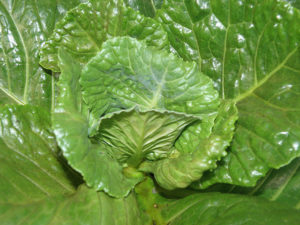
Cabbage leaves
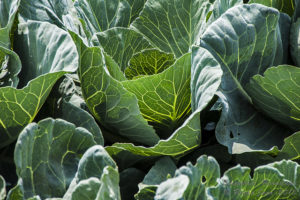
Close-up of cabbage foliage
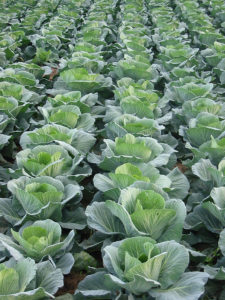
Field of cabbages
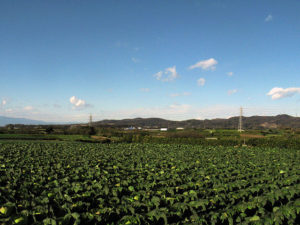
Fields of cabbage
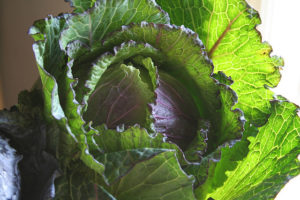
Red cabbage
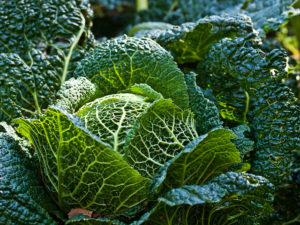
Cabbage leaves
Uses
Cabbage is primarily grown for consumption as a vegetable, eaten after boiling or steaming. Some cultivars are grown as fodder for animals. Red cabbage is commonly pickled.
Propagation
Basic requirements Cabbage is cool season crop that grows best in cool, moist conditions. The plant will grow best at temperatures between 4 and 21°C (40–50°F) allowing it to be grown in both Spring and Fall. Cabbage will grow optimally in a rich, moist, well draining soil With a pH of 6.5. The plant requires at least six hours of direct sunlight every day. Sowing seeds Cabbage can be direct seeded or started indoors to produce transplants. The optimum soil temperature for germination is between 12 and 24°C (55–75°F). Cabbage seeds can be planted outdoors 6–8 weeks before the last spring frost date in a cold frame and transplanted to their final location approximately 4 weeks before the last frost. If planting for a fall harvest, cabbage can be direct seeded 6–8 weeks before the first frost date. Prepare the soil for planting through the addition of nitrogen in the form of bone meal or composted manure. Plant cabbage seeds 6 mm (0.25 in) deep allowing 10–15 cm (4–6 in) between plants in the row and a 0.6 to 1.2 m (2–4 ft) between rows. Thin seedlings to a final within row spacing of 45–60 cm (18–24 in). Keep soil moist during germination to prevent a crust from forming on the soil surface as this will cause uneven germination. Transplanting Seedlings started indoors or in a cold frame are ready to be transplanted when they have 3–4 leaves and the daytime temperature has reached 10°C (50°F). Seedling should be planted at the final spacing for seeds (45–60 cm/18–24 in between plants and 0.6 to 1.2 m/2–4 ft between rows). Plant each seedling slightly deeper than it was previously. The plantings can be staggered in 2 week intervals to prolong the harvest. General care and maintenance Cabbage should be kept evenly watered to ensure the development of tight heads. Uneven watering can cause heads to crack. Application of mulch around plants helps to conserve soil moisture. Cabbage plants have shallow roots and in order to avoid damaging them, it is preferable to hand pull any weeds growing around the plants. Cabbages are heavy feeders and require the addition of fertilizer to meet their growth requirements and develop optimally. Fertilize the plants when they are beginning to form new leaves and starting to develop heads. Harvesting Cabbages are ready to harvest when the head is fully formed and feels firm and well-packed when squeezed. Cut the head away from the stalk with a sharp knife. Leaving the stalks in the ground will result in the formation of several smaller heads which can also be harvested and eaten.
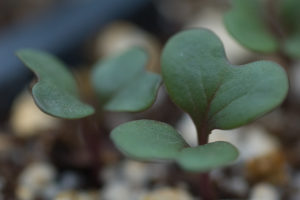
Cabbage seedlings
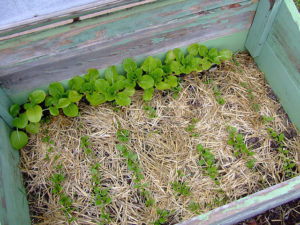
Cabbages can be started in a cold frame and transplanted
References
CABI Crop Protection Compendium. (2008). Brassica oleracea datasheet. Available at: http://www.cabi.org/cpc/datasheet/10102. [Accessed 07 November 14]. Paid subscription required. Delahaut, K. A. & Newenhouse, A. C. (1997). Growing Broccoli, Cauliflower, Cabbage and other Cole crops in Wisconsin. A Guide for Fresh-Market Growers. University of Wisconsin Cooperative Extension. Available at: http://learningstore.uwex.edu/assets/pdfs/A3684.PDF. [Accessed 07 November 14]. Free to access Rimmer, S. R., Shattuck, V. I. Buchwaldt, L. (Eds) (2007). Compendium of Brassica Diseases. American Phytopathological Society Press. Available at: http://www.apsnet.org/apsstore/shopapspress/Pages/43443.aspx. Available for purchase from APS Press.
Common Pests and Diseases
Diseases
Category : Fungal
Alternaria leaf spot (Black spot, Gray spot) Alternaria brassicae
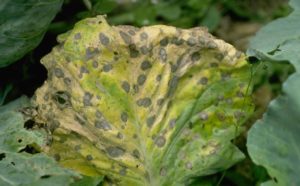
Symptoms of Alternaria leaf spot on cabbage
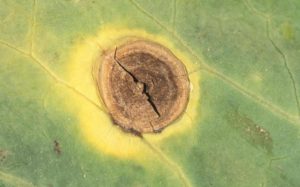
Close-up of Alternaria lesion on cabbage leaf
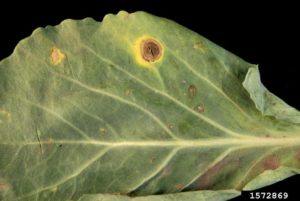
Leaf spot on cabbage caused by Alternaria brassicicola

Black spot infected cabbage leaf
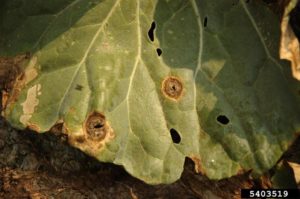
Concentric balck spots on leaf
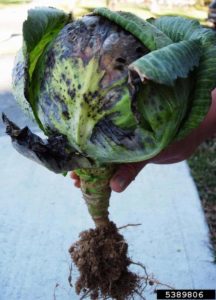
(Cabbage infected withblack spot (Alternaria brassicicola
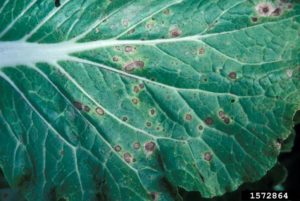
Chinese cabbage leaf showing many lesions caused by Alternaria brassicicola
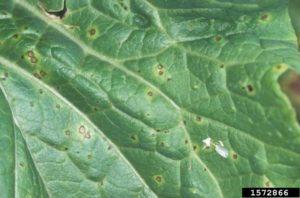
Initial symptoms on Chinese cabbage leaf
Symptoms
Small dark spots on leaves which turn brown to gray; lesions may be round or angular and may possess a purple-black margin; lesions may form concentric rings, become brittle and crack in center; dark brown elongated lesions may develop on stems and petioles.
Cause
Fungus
Comments
May become a problem on cabbage during cool, wet periods.
Management
Plant only pathogen-free seed; rotate crops; applications of appropriate fungicides control disease when present.
Anthracnose Colletotrichum higginsianum
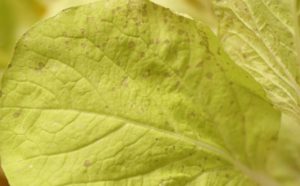
Anthracnose symptoms on cabbage leaf
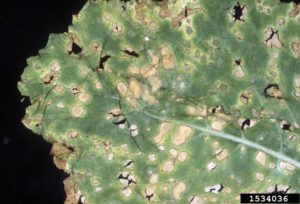
anthracnose (Colletotrichum higginsianum) symptoms on turnip leaf
Symptoms
Small circular or irregularly shaped dry spots which are gray to straw in color on leaves; a high number of spots may cause the leaf to die; lesions may coalesce to form large necrotic patches causing leaves to turn yellow and wilt; lesions may split or crack in dry centers.
Cause
Fungus
Comments
Fungus overwinters on leaf debris and on related weeds; disease emergence is favored by moist, warm conditions.
Management
Control of disease depends on sanitary practices; treat seeds with hot water prior to planting; rotate crops; plant in an area with good soil drainage; remove all cruciferous weeds which may act as a reservoir for the fungus.
Black rot Xanthomonas campestris.
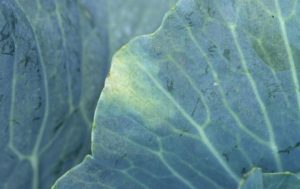
Early symptoms of black rot showing V-shaped lesion on cabbage leaf
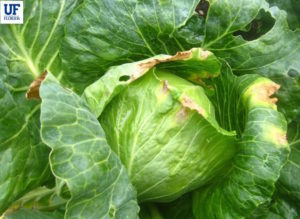
Black rot symptoms include large lesion on the margin of the leaves that causes sever leaf damage and yield losses on cabbage.

The symptoms starts as V-shaped yellow lesions to the margin of the leaves. If the disease infection starts early i the season the entire plant can be severely affected. Blackened veins is another major symptom of black rot on cabbage.

Cabbage leaf with scorched appearance cuased by black rot infection
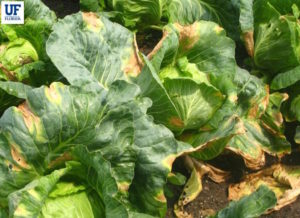
A field with severe infection of black rot
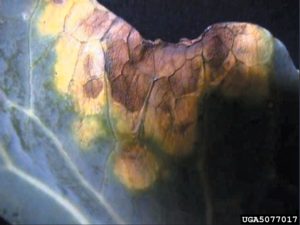
Initial infection begins as yellow “V” shaped spot on edge of leaf. Black veins eventually appear as infection spreads.
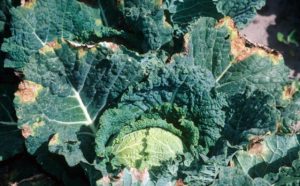
Savoy cabbage infected with black rot
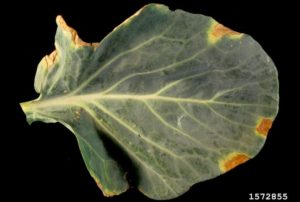
Typical V-shaped marginal chlorosis and necrosis caused by black rot.
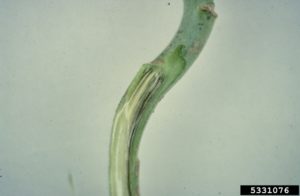
Symptoms on stem

Symptoms on stem
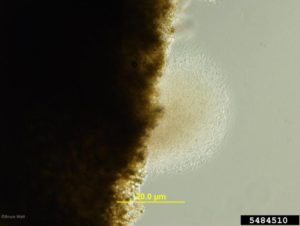
Bacterial streaming from cut tissue
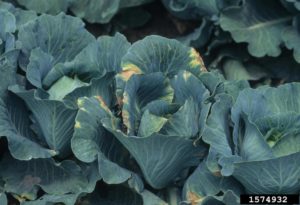
Classic bright yellow lesions at the leaf margins
Symptoms
Irregularly shaped dull yellow areas along leaf margins which expand to leaf midrib and create a characterstic “V-shaped” lesion; lesions may coalesce along the leaf margin to give plant a scorched appearance.
Cause
Bacterium
Comments
Pathogen is spread via infected seed or by splashing water and insect movement; disease emergence favored by warm and humid conditions.
Management
Primary method of controlling black rot is through the use of good sanitation practices; rotate crops to non-cruciferous crops every 2 years; plant resistant varieties; control cruciferous weed species which may act as a reservoir for bacteria; plant pathogen-free seed.
Clubroot Plasmodiophora brassicae
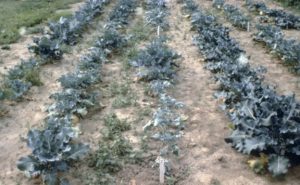
Cabbages in field showing symptoms of poor growth due to club root

Distorted roots of cabbage plant caused by infection with club root fungus
Symptoms
Cause
Comments
Management
Once the pathogen is present in the soil it can survive for many years, elimination of the pathogen is economically unfeasible; rotating crops generally does not provide effective control; plant only certified seed and avoid field grown transplants unless produced in a fumigated bed; applying lime to the soil can reduce fungus sporulation
Damping-off (Wirestem, Head rot) Rhizoctonia solani

Rotting lesion on cabbage leaf caused by infection with Rhizoctonia
Symptoms
Cause
Comments
Management
Plant pathogen-free seed or transplants that have been produced in sterilized soil; apply fungicide to seed to kill off any fungi; shallow plant seeds or delay planting until soil warms
Powdery mildew Erysiphe cruciferarum

Powdery mildew Erysiphe cruciferarum

Powdery mildew
Symptoms
Cause
Comments
Management
Plant resistant varieties; rotate crops; remove all crop debris after harvest; remove weeds; avoid excessive application of nitrogen fertilizer which encourages powdery mildew growth; powdery mildew can be controled by application of sulfur sprays, dusts or vapors
Sclerotinia stem rot (White mold) Sclerotinia sclerotiorum
Symptoms
Cause
Comments
Management
Rotate crop to non-hosts (e.g. cereals) for at least 3 years; control weeds; avoid dense growth by planting in adequately spaced rows; apply appropriate foliar fungicides
Watery soft rot (White rot, Cabbage drop) Sclerotinia sclerotiorum
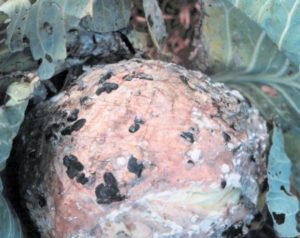
Cabbage infected with Sclerotinia
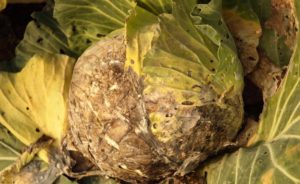
Cabbage head infected with Sclerotinia
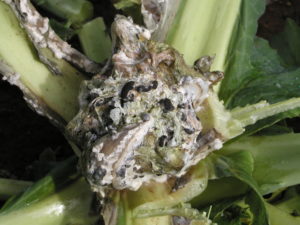
Sclerotinia fungus on cauliflower
Symptoms
Cause
Comments
Management
The number of sclerotia in the soil can be reduced by plowing crop debris deep into soil and rotating crops every 3 years with non-host crops; severe infestations may require control through application of appropriate fungicide
White rust Albugo candida
Symptoms
Cause
Comments
Management
Rotate crops; plant only disease-free seed; apply appropriate fungicide if disease becomes a problem
Category : Bacterial
Bacterial soft rot Erwinia caratovora

Bacterial soft rot on cabbage

Bacterial soft rot on cabbage
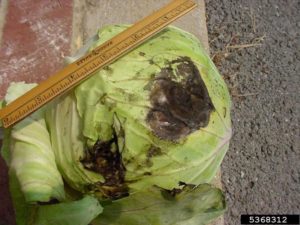
Cabbage head with decay from soft-rotting, bacterial infection.
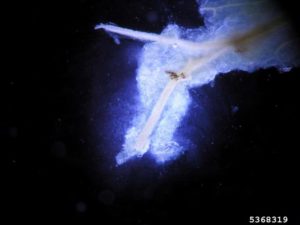
Bacteria streaming from soft-rotted tissue under dark-field observation.
Symptoms
Cause
Comments
Management
Chemical treatments are not available for bacterial soft rot, control relies on cultural practices; rotate crops; plant cabbage in well-draining soils or raised beds; only harvest heads when they are dry; avoid damaging heads during harvest.
Blackleg Leptosphaeria maculans

Leaf disease symptoms caused by Leptosphaeria maculans on Brassica napus. The leaf on the left shows necrosis caused by the fungus include production of black pycnidia within the white lesions, whereas the younger leaf on the right is relatively disease free.
Symptoms
Cause
Comments
Management
Cabbage does not have high levels of resistance to blackleg and fungicides use is uneconomical; use disease free seed or treat with hot water to remove fungus prior to planting; remove and destroy crop debris after harvest or plow deeply into soil.
Category : Fungal, Oomycete
Downy mildew Peronospora parasitica
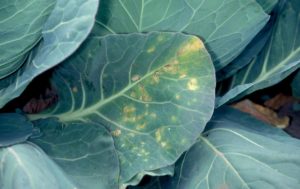
Downy mildew symptoms on cabbage leaf
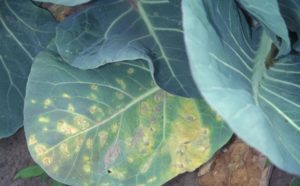
Downy mildew symptoms on cabbage leaf
Symptoms
Irregular yellow patches on leaves which turn light brown in color; fluffy gray growth on the undersides of the leaves
Cause
Fungus
Comments
Disease emergence favored by cool, moist conditions
Management
Remove all crop debris after harvest; rotate with non-brassicas; application of appropriate fungicides may be required if symptoms of disease are present
Category : Viral
Ring spot Mycosphaerella brassicicola
Symptoms
Cause
Comments
Management
Refrain from planting in areas known to have had disease previously; rotate crop to non-brassicas; sanitize tools and equipment regularly; apply appropriate fungicide if disease is identified in crop
Category : Other
Slugs & snails (Gray garden slug, Spotted garden slug, Brown garden snail, European garden snail , etc.) Decoratus reticulatum
Limax maximus
Helix aspersa
Cornu aspersum
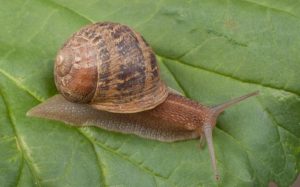
European brown snail

Gray garden slug
Symptoms
Cause
Comments
Management
Practice good garden sanitation by removing garden trash, weeds and plant debris to promote good air circulation and reduce moist habitat for slugs and snails; handpick slugs at night to decrease population; spread wood ashes or eggshells around plants; attract molluscs by leaving out organic matter such as lettuce or grapefruit skins, destroy any found feeding on lure; sink shallow dishes filled with beer into the soil to attract and drown the molluscs; chemical controls include ferrous phosphate for organic gardens and metaldehyde (e.g. Buggeta) and carbaryl (e.g Sevin bait) for non-organic growers.
Pests
Category : Insects
Beet armyworm Spodoptera exigua
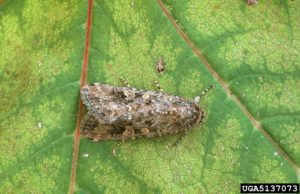
Beet armyworm adult
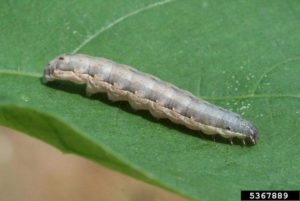
Larva of beet armyworm
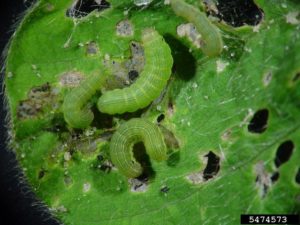
beet armyworm (Spodoptera exigua) larvae on soybean leaf
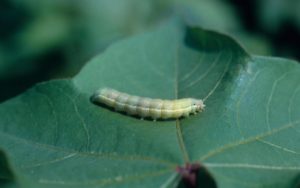
Beet armyworm larva

Beet armyworm eggs covered in white hairs
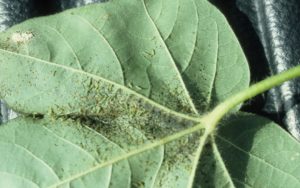
Young larvae
Symptoms
Cause
Comments
Management
Organic methods of controlling the beet armyworm include biological control by natural enemies which parasitize the larvae and the application of Bacillus thuringiensis; there are chemicals available for commercial control but many that are available for the home garden do not provide adequate control of the larvae.
Cabbage aphid Brevicoryne brassicaea
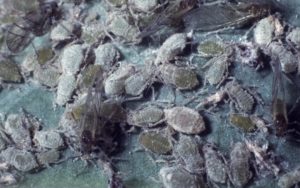
Cabbage aphid colony on a cabbage leaf

Cabbage aphid adult
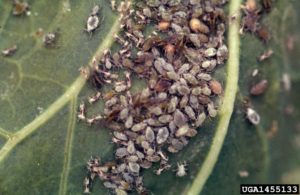
Aphid colony
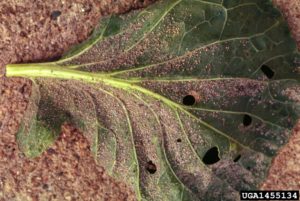
Heavily infested leaf
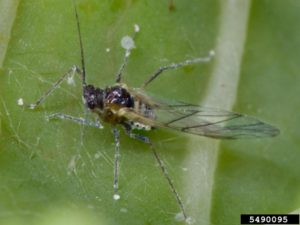
Adult aphid
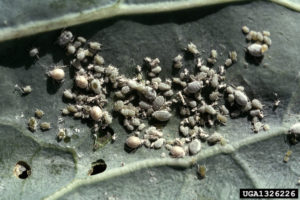
Multiple life stage

Heavy infestation of cabbage leaves
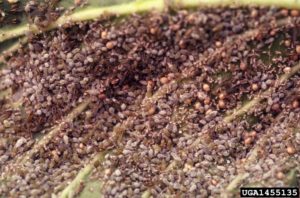
Dense colony
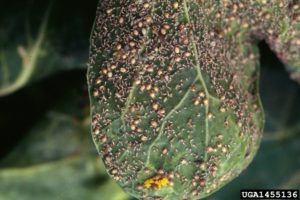
Lady beetles feeding on aphids
Symptoms
Cause
Comments
Management
If aphid population is limited to just a few leaves or shoots then the infestation can be pruned out to provide control; check transplants for aphids before planting; use tolerant varieties if available; reflective mulches such as silver colored plastic can deter aphids from feeding on plants; sturdy plants can be sprayed with a strong jet of water to knock aphids from leaves; insecticides are generally only required to treat aphids if the infestation is very high – plants generally tolerate low and medium level infestation; insecticidal soaps or oils such as neem or canola oil are usually the best method of control; always check the labels of the products for specific usage guidelines prior to use.
Cabbage looper Trichoplusia ni
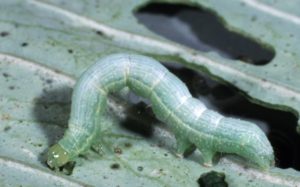
Cabbage looper feeding on cabbage leaf
Symptoms
Cause
Comments
Management
Management may be needed after cabbage heading; biological controls such as spraying with Bacillus thuringiensis can be effective at controlling looper numbers; application of appropriate insecticide after heading also controls looper populations; selective insecticides help to protect populations of natural enemies on crop
Cutworms Agrotis spp.
Peridroma saucia
Nephelodes minians
and others
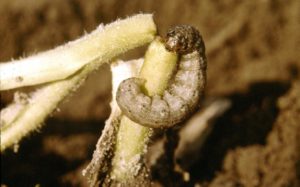
Cutworm larva severing plant stem
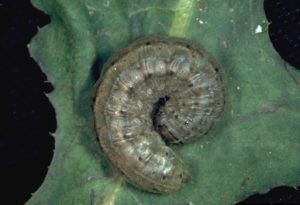
Cutworms will curl up into a characteristic C shape when disturbed
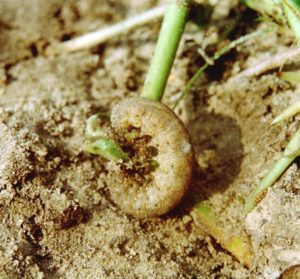
Cutworm feeding on plant stem
Symptoms
Cause
Comments
Management
Remove all plant residue from soil after harvest or at least two weeks before planting, this is especially important if the previous crop was another host such as alfalfa, beans or a leguminous cover crop; plastic or foil collars fitted around plant stems to cover the bottom 3 inches above the soil line and extending a couple of inches into the soil can prevent larvae severing plants; hand-pick larvae after dark; spread diatomaceous earth around the base of the plants (this creates a sharp barrier that will cut the insects if they try and crawl over it); apply appropriate insecticides to infested areas of garden or field if not growing organically
Diamondback moth Plutella xylostella
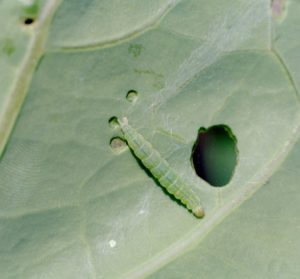
Larva feeding on cabbage leaf
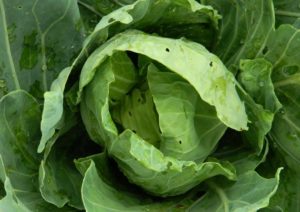
Cabbage damaged by Diamondback moth larvae
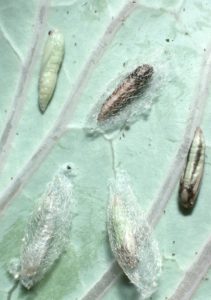
Diamondback moth pupae
Symptoms
Cause
Comments
Management
Larvae can be controlled organically by applications of Bacillus thurengiensis or Entrust; application of appropriate chemical insecticide is only necessary if larvae are damaging the growing tips of the plants
Flea beetle Phyllotreta spp.
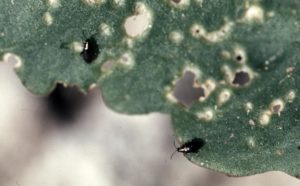
Crucifer flea beetles and damage on cabbage leaf
Symptoms
Cause
Comments
Management
In areas where flea beetles are a problem, floating row covers may have to be used prior to the emergence of the beetles to provide a physical barrier to protect young plants; plant seeds early to allow establishment before the beetles become a problem – mature plants are less susceptible to damage; trap crops may provide a measure of control – cruciferous plants are best; application of a thick layer of mulch may help prevent beetles reaching surface; application on diamotecoeus earth or oils such as neem oil are effective control methods for organic growers; application of insecticides containing carbaryl, spinosad, bifenthrin and permethrin can provide adequate control of beetles for up to a week but will need reapplied
Large cabbage white (Cabbageworm) Pieres rapae
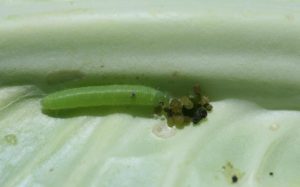
Cabbageworm and frass on a cabbage leaf
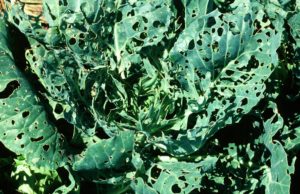
Cabbage damaged by cabbageworm
Symptoms
Cause
Comments
Management
Plant can tolerate quite a lot of damage from caterpillars between transplanting and heading; hand pick caterpillars from plants and destroy; scrape eggs from leaves prior to hatching; apply appropriate insecticide if infestation is very heavy
Thrips (Western flower thrips, Onion thrips, etc) Frankliniella occidentalis
Thrips tabaci
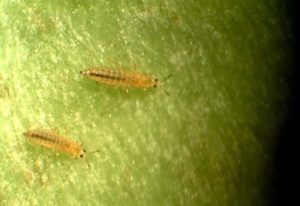
Western flower thrips
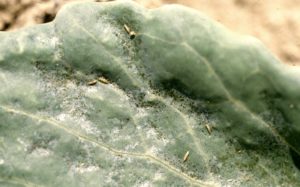
Onion thrips on cabbage
Symptoms
Cause
Comments
Management
Avoid planting next to onions, garlic or cereals where very large numbers of thrips can build up; use reflective mulches early in growing season to deter thrips; apply appropriate insecticide if thrips become problematic
Category : Nematodes
Root knot nematode Meloidogyne spp.
Symptoms
Cause
Comments
Management
Plant resistant varieties if nematodes are known to be present in the soil ;check roots of plants mid-season or sooner if symptoms indicate nematodes; solarizing soil can reduce nematode populations in the soil and levels of inoculum of many other pathogens



